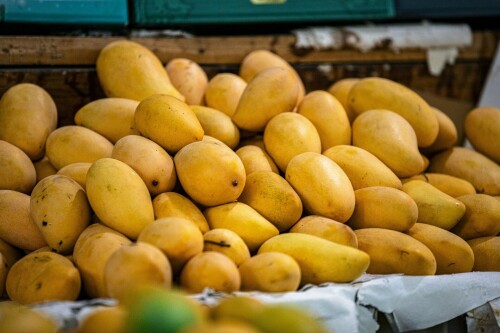Sindhri Mango Eyes Global Markets with GI Registration
Exporters, importers, progressive agriculturists, and authorities have advocated for the promotion of Sindhri Mango in the international marketplace. They also emphasized the importance of research and development to underscore intellectual property rights.
These points were raised at the official launch of Sindhri Mango as a registered Geographical Indication (GI) of Pakistan. The aim is to enhance awareness among consumers, exporters, and stakeholders regarding the value and potential of GIs.
A GI signifies products with a specific geographical origin, possessing qualities and a reputation attributable to the natural and human elements of that origin. GIs serve as a brand, guaranteeing authenticity and representing the unique attributes of the products.
On January 3, 2023, the Trade Development Authority of Pakistan (TDAP) secured GI status for ‘Sindhri Mango’ from the GI Registrar, Intellectual Property Organisation (IPO) of Pakistan.
Stakeholders emphasized that GI protection is crucial for boosting the rural economy, agricultural branding, and export development.
Geographical Indications are a potent tool for promoting Pakistan’s unique, origin-linked products globally. The GI registration of Sindhri Mango marks a significant advancement in safeguarding and branding Pakistan’s renowned mangoes. Predominantly grown in Sindh and parts of Punjab, Sindhri Mango is prized for its vibrant yellow hue, distinctive aroma, and delectable sweetness.
To commemorate this achievement, the IPO of Pakistan, in collaboration with the UN-World Intellectual Property Organisation (WIPO), hosted a launch event for the Sindhri mango GI at a shopping center on Thursday.
IPO Chairman Farukh Amil noted that agriculture accounts for 23% of the country’s GDP, with 37% of the population engaged in the sector.
Highlighting the importance of protecting agriculture, knowledge, heritage, and inventions, he stated, “Today signifies a landmark in Pakistan’s intellectual property journey: the official unveiling of Sindhri Mango as a Geographical Indication. This occasion celebrates not just a fruit, but a legacy—a product originating from the soil of Sindh, cultivated by generations of skilled farmers. This launch signifies a commitment to honour our heritage, empower our producers, and promote Pakistan’s GI portfolio worldwide. Let this triumph motivate all stakeholders to collaborate for effective enforcement of GI rights, enhanced branding of other Pakistani GI products, and active involvement of growers and exporters in the GI system.”
He further added that Sindhri Mango, a national treasure, stands as one of Pakistan’s most valuable agricultural exports. Its unique quality is intrinsically linked to its region of origin, primarily Sindh and parts of southern Punjab.
Amil emphasized that GIs are more than mere legal instruments; they are economic assets that help safeguard authenticity, ensure product quality, and unlock new trade opportunities. GI protection for Sindhri Mango will uphold its reputation, standardize its quality, ensure that only genuine producers benefit from its growing market appeal, and promote fair recognition and improved prices for local farmers.
He stated that the launch underscores Pakistan’s dedication to bolstering rural economies, agricultural branding, and export-oriented growth.
“Sindhri’s GI registration represents a stride towards realizing the global potential of numerous other origin-linked Pakistani products. It fosters collaboration among federal institutions, provincial governments, and growers’ associations.”
Chairman of All Pakistan Fruits & Vegetables Exporters, Importers and Merchants Association, Aslam Pakhali, commented that while Sindhri Mango is unmatched by Indian varieties, India has established a stronger brand presence due to a lack of vision in Pakistan. He added that the characteristics of mangoes evolve daily.
Pakhali explained, “Our association aimed for an export target of 125,000 tonnes of mangoes this year nationwide, but we fell short due to various factors, including adverse weather, the conflict in Iran, and other challenges.”
“For instance, the Japanese prioritize visual appeal, while we focus on aroma. Why can’t we create an attractively presented mango due to a lack of research and development? Sindh produces approximately 300,000 to 350,000 tonnes of mangoes on average, including all varieties. Sindh has the potential to produce significantly superior mangoes,” he stated.
Punjab produced approximately 1.5 million tonnes of mangoes last year, with exports ranging from 100,000 to 150,000 tonnes. Pakhali asserted that while mango exports are substantial, quality remains a concern.
Sindh Abadgar Board (SAB) President Syed Mahmood Nawaz Shah explained that IPO grants the rights to market and sell a product, preventing others from selling the registered product worldwide.
“Sindhri Mango boasts a unique taste and GI. Transplanting it to another region or country will not yield the same Sindhri mango due to geographical variations,” he concluded.



Comments (0)
No comments yet. Be the first to comment!
Leave a Comment